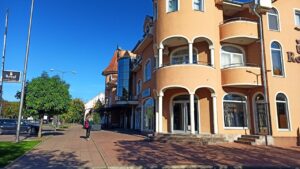The evolution of housing: from medieval castles to modern skyscrapers.
The evolution of housing is a fascinating journey that reflects the changing needs, technologies, and social structures of human civilization. From the imposing medieval castles that symbolized power and protection to the sleek, towering skyscrapers that define modern city skylines, the way we build and inhabit our homes has undergone a profound transformation. This article explores the key stages in the evolution of housing, highlighting the architectural innovations and cultural shifts that have shaped our living environments over the centuries.
Medieval Castles: Fortresses of Power and Protection
During the medieval period, housing was primarily a reflection of social hierarchy and the need for defense. Castles emerged as the residences of nobility, designed not only for comfort but also for protection against invaders. These formidable structures were characterized by thick stone walls, moats, and towers, serving as both homes and fortifications. The architecture of castles varied significantly across regions, influenced by local materials and climatic conditions, yet they all shared the common purpose of safeguarding their inhabitants.
Inside these castles, the living quarters were often austere, with large halls serving as communal spaces for dining and entertainment. The layout was functional, with separate areas designated for different activities, such as sleeping, cooking, and storage. Despite their imposing exterior, castles were also centers of culture and governance, where lords held court and hosted feasts. The design of these structures reflected the feudal system, emphasizing the power dynamics of the time, as well as the importance of status and lineage.
As the medieval period progressed, the need for fortified homes began to wane, giving way to more comfortable and aesthetically pleasing residences. The decline of feudalism and the rise of the merchant class led to the construction of grand manor houses and palaces, which combined elements of defense with luxury. This transition marked the beginning of a new era in housing, where comfort and style began to take precedence over mere survival.
The Renaissance and the Birth of Urban Living
The Renaissance brought about a significant shift in architectural styles and housing concepts. As cities began to grow, the focus moved from isolated castles to urban living, with an emphasis on aesthetics and humanism. The introduction of classical elements, such as columns and arches, transformed the design of homes and public buildings alike. Wealthy merchants and aristocrats commissioned elaborate townhouses that showcased their status and taste, often featuring intricate facades and spacious interiors.
During this period, the concept of the «home» evolved to include not just a place of shelter but also a space for social interaction and cultural expression. The design of homes began to incorporate gardens, courtyards, and communal areas, reflecting the Renaissance ideals of beauty and harmony with nature. This shift was further fueled by advancements in construction techniques and materials, allowing for larger windows, higher ceilings, and more intricate designs.
As urbanization continued to accelerate, the demand for housing in cities led to the development of tenements and apartment buildings. These multi-family dwellings catered to the growing population and marked a departure from the single-family homes of the past. The rise of the middle class during the Industrial Revolution further influenced housing trends, as people sought affordable yet comfortable living spaces in urban centers.
The Industrial Revolution and the Rise of Skyscrapers
The Industrial Revolution marked a turning point in the evolution of housing, driven by rapid urbanization and technological advancements. The introduction of steel and reinforced concrete revolutionized construction, enabling architects to design taller and more complex structures. This era saw the emergence of skyscrapers, which became symbols of modernity and economic progress. Cities like New York and Chicago became known for their iconic skylines, showcasing the possibilities of vertical living.
Skyscrapers not only transformed the physical landscape of cities but also redefined the concept of community. With the rise of office buildings and commercial spaces, urban dwellers began to experience a new way of life, where work and home were often in close proximity. This shift led to the development of mixed-use buildings, where residential, commercial, and recreational spaces coexisted, fostering a sense of community in bustling urban environments.
However, the rapid growth of cities also brought challenges, such as overcrowding and inadequate housing conditions. In response, urban planners and architects began to focus on sustainable and inclusive housing solutions. The late 20th and early 21st centuries saw a renewed emphasis on eco-friendly designs, affordable housing initiatives, and the integration of green spaces within urban settings. This ongoing evolution reflects a growing awareness of the need for balance between urban development and the well-being of residents.
The journey from medieval castles to modern skyscrapers illustrates the dynamic nature of housing and its ability to adapt to societal changes. Each architectural style and housing concept has been shaped by the historical context in which it emerged, reflecting the values, technologies, and aspirations of the time. As we look to the future, the evolution of housing will undoubtedly continue, driven by innovation and the pressing need for sustainable living solutions in an ever-changing world. The challenge lies in creating spaces that not only meet the demands of modern life but also foster a sense of community and connection among their inhabitants.


